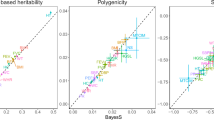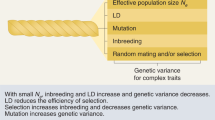Abstract
Reply to: J. Hermisson & A. P. McGregor Nature 456, 10.1038/nature07452 (2008)
In our paper on pleiotropic scaling and the cost of complexity1, we presented evidence for three findings: first, most genes affect a small number of traits (the degree of pleiotropy is low); second, the total effect of a quantitative trait locus (QTL) increases with the degree of pleiotropy, refuting the constant total effect model2,3; and third, the increase in total effect (defined as  , where Ai is the effect on character i, that is, half the difference between the genotypic values of the homozygous genotypes) seems to be stronger than predicted by the superposition model4,5 of pleiotropic effects. Hermisson and McGregor6 point out that the last result could be due to multiple mutations being mapped to the same QTL, but only if these mutations affect overlapping sets of traits. We agree that this is a possibility that we could not address with the data at hand.
, where Ai is the effect on character i, that is, half the difference between the genotypic values of the homozygous genotypes) seems to be stronger than predicted by the superposition model4,5 of pleiotropic effects. Hermisson and McGregor6 point out that the last result could be due to multiple mutations being mapped to the same QTL, but only if these mutations affect overlapping sets of traits. We agree that this is a possibility that we could not address with the data at hand.
This is a preview of subscription content, access via your institution
Access options
Subscribe to this journal
Receive 51 print issues and online access
$199.00 per year
only $3.90 per issue
Buy this article
- Purchase on Springer Link
- Instant access to full article PDF
Prices may be subject to local taxes which are calculated during checkout
Similar content being viewed by others
References
Wagner, G. P. et al. Pleiotropic scaling of gene effects and the 'cost of complexity'. Nature 452, 470–472 (2008)
Orr, H. A. Adaptation and the cost of complexity. Evolution Int. J. Org. Evolution 54, 13–20 (2000)
Wingreen, N. S., Miller, J. & Cox, E. C. Scaling of mutational effects in models of pleiotropy. Genetics 164, 1221–1228 (2003)
Turelli, M. Effects of pleiotropy on predictions concerning mutation-selection balance for polygenic traits. Genetics 111, 165–195 (1985)
Wagner, G. P. The influence of variation and of developmental constraints on the rate of multivariate phenotypic evolution. J. Evol. Biol. 1, 45–66 (1988)
Hermisson, J. & McGregor, A. P. Pleiotropic scaling and QTL data. Nature 456 10.1038/nature07452 (2008)
Author information
Authors and Affiliations
Rights and permissions
About this article
Cite this article
Wagner, G., Kenney-Hunt, J., Pavlicev, M. et al. Wagner et al. reply. Nature 456, E4 (2008). https://doi.org/10.1038/nature07453
Published:
Issue Date:
DOI: https://doi.org/10.1038/nature07453
This article is cited by
-
Sexual Dimorphism Increases Evolvability in a Genetic Regulatory Network
Evolutionary Biology (2011)
Comments
By submitting a comment you agree to abide by our Terms and Community Guidelines. If you find something abusive or that does not comply with our terms or guidelines please flag it as inappropriate.



